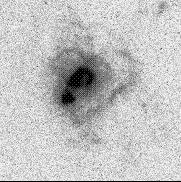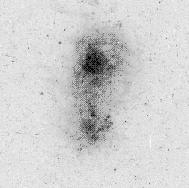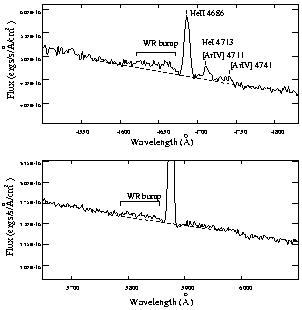


5.1 IZw18
The blue compact galaxy IZw18 (also known as Markarian 116) was first described by Zwicky in 1966. IZw18 is the galaxy with the lowest known metallicity as derived from the ionised gaseous component. Its oxygen abundance is only ~ 1/50 of that of the Sun. Thus, often being referred to as ``the most metal-poor galaxy known'', it is still two orders of magnitude more metal rich than the most metal-poor stars in the Milky way. It is intriguing that while IZw18 was the first BCG (together with II Zw40) in which ionised gas abundances were investigated (Searle & Sargent 1972), it remains still the most metal-poor BCG known, despite large efforts in searching for more metal-poor ones.
Neutral hydrogen in IZw18 was detected by
Chamaraux (1977),
and further investigated using aperture synthesis by
Lequeux and
Viallefond (1980)
who derived MH II =
7 . 107 M .
Viallefond et
al. (1987)
mapped the galaxy in H I with VLA and from
the velocity field inferred a mass Mdyn
.
Viallefond et
al. (1987)
mapped the galaxy in H I with VLA and from
the velocity field inferred a mass Mdyn  9
. 108 M
9
. 108 M .
Van Zee et al. (1998a)
made a high resolution VLA study of IZw18 which
revealed a complex
HI morphology and velocity field. A complex velocity field was also
found in the ionised component
(Martin 1996,
Petrosian et al. 1997).
Molecular gas has not been detected, not surprising given the low metallicity.
Moreover, low extinction is reported in most studies and the galaxy is
not detected by the InfraRed Astronomical Satellite IRAS (IZw18 has not been observed with the
Infrared Satellite Observatory, ISO), indicating a low dust content.
Deep spectra revealed that IZw18 contains Wolf-Rayet stars
(Fig. 7;
Legrand et al. 1997b;
Izotov et al. 1997a)
showing that such can exist even at very low metallicities. HST
imaging in the optical
(Hunter and Thronson
1995,
Dufour et al. 1996)
and near infrared
(Östlin 1999a)
resolves the galaxy into individual luminous stars, and shows
that the star formation has been active for at least 30 Myrs, with
indications of an even older stellar population
(see below). In Fig. 5 we show an H
.
Van Zee et al. (1998a)
made a high resolution VLA study of IZw18 which
revealed a complex
HI morphology and velocity field. A complex velocity field was also
found in the ionised component
(Martin 1996,
Petrosian et al. 1997).
Molecular gas has not been detected, not surprising given the low metallicity.
Moreover, low extinction is reported in most studies and the galaxy is
not detected by the InfraRed Astronomical Satellite IRAS (IZw18 has not been observed with the
Infrared Satellite Observatory, ISO), indicating a low dust content.
Deep spectra revealed that IZw18 contains Wolf-Rayet stars
(Fig. 7;
Legrand et al. 1997b;
Izotov et al. 1997a)
showing that such can exist even at very low metallicities. HST
imaging in the optical
(Hunter and Thronson
1995,
Dufour et al. 1996)
and near infrared
(Östlin 1999a)
resolves the galaxy into individual luminous stars, and shows
that the star formation has been active for at least 30 Myrs, with
indications of an even older stellar population
(see below). In Fig. 5 we show an H and a V-band image, and in Fig. 6
an optical spectrum of IZw18.
and a V-band image, and in Fig. 6
an optical spectrum of IZw18.

| 
|
Figure 5. Left: Continuum
subtracted H | |

|
Figure 6. An spectrum of IZw18, with the
most important emission lines labelled.
Note the very blue continuum. That IZw18 is a very low abundance object
can be seen by
noting the following: [O III] |

|
Figure 7. This figure shows the very weak Wolf-Rayet features detected in a high S/N spectrum of IZw18 (Legrand et al. 1997b; see also Izotov et al. 1997a). (Courtesy F. Legrand). |